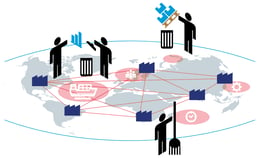5 Pitfalls in S&OE Implementation
Brian Hoey - April 07, 2020

 We’ve written on this blog before that sales and operations execution (S&OE) can be a game-changer in terms of keeping S&OP goals on track—and we’re not alone. Gartner, who coined the term S&OE several years ago, has been touting the virtues of a focus on daily and weekly supply chain execution for years. As with so many high-upside supply chain strategies and paradigms, though, there’s always an open question about how best to implement a new process or strategy. Many businesses still struggle with successful S&OP implementation, and it’s hard to imagine that S&OE would be much easier.
We’ve written on this blog before that sales and operations execution (S&OE) can be a game-changer in terms of keeping S&OP goals on track—and we’re not alone. Gartner, who coined the term S&OE several years ago, has been touting the virtues of a focus on daily and weekly supply chain execution for years. As with so many high-upside supply chain strategies and paradigms, though, there’s always an open question about how best to implement a new process or strategy. Many businesses still struggle with successful S&OP implementation, and it’s hard to imagine that S&OE would be much easier.
Below, you’ll find five of the top S&OE implementation pitfalls that supply chain planners and other stakeholders might encounter—plus some thoughts on how to overcome them. Even in highly technologically advanced planning environments, a little bit of information can go a long way towards making smarter, more adaptable workflows a reality.
1. Connecting the Wrong Data Sources
When it comes to making S&OP roadmaps, planners need to look at dataflows from every touchpoint on the supply chain—from production planning to sourcing to order creation—in order to create robust forecasts and plans for meeting demand. With S&OE, the purview is more limited: your primary concerns are with inventory levels and transport plans. This means that it’s particularly imperative that your S&OE dashboard is showing accurate information from the right sources. As a result, you need to be able to visualize up-to-date information on:
- Current S&OP plans
- Existing inventory levels and warehouse capacity
- Current transport plans
In a perfect world, gaining visibility into these things would be fairly straightforward, but in many supply chains it could take some work to figure out where your best sources of information actually live.
2. Not Integrating Real-time
Once you’ve gotten a planning environment with the right data streams set up, it’s time to implement real-time planning. Because S&OE workflows are designed to power short term operational decision-making, planners in this area need to be empowered to gain information and enact changes to the operational plans at lightning speed. This means that getting daily updates from inventory managers isn’t ideal; neither is getting information on transport plans that have no live insights into where your freight is at any given moment. Ultimately, this is where the intersection S&OE and Industry 4.0 comes into focus for many planners. Why? Because new technology like the IoT (internet of things), smart pallets, and smart ports that offer real-time tracking and analysis of cargo and ship movement can be critical for planners who are trying to identify and address potential disruptions before they occur. Without the introduction of technology that enhances visibility and powers real-time updates, it will be difficult for S&OE to maximize its value—because it will always be a step behind what’s actually happening in your supply chain.
3. Weak Separation from S&OP
This one is particularly important: too many planners treat S&OP and S&OE as a mishmash of indistinct processes, and the result is that neither process works as well as it should. In fact, combining these two processes defeats the entire purpose of S&OE, which to empower longer term planners to keep their eyes on the big picture without getting bogged down by—or overreacting to—small fluctuations in demand or inventory levels. Though these two functions will need to share information and potentially some IT infrastructure, each one should get its own dedicated meeting and the leeway to make changes within its organizational purview. This means that S&OP meetings shouldn’t ever waste time dwelling on operational questions, just as S&OE meetings shouldn't zoom out into big picture strategic questions. In this way, you can create two separate functions that work toward goals that are separate but related. S&OP can create a plan for the coming quarter or year based on projected demand and capacity, while S&OE can maintain week-to-week supply chain stability while providing feedback for future S&OP planning flows.
4. Taking on Too Much… or Too Little
This is related to the section above, but it bears a quick discussion of its own. If you’re using the latest technology to empower S&OE planners to make snap decisions in the face of disruptions, or to make data-driven changes to select parts of the value chain, it’s tempting to wonder if S&OE planning workflows should be expanded to other departments and functions as well. This kind of thinking can be a trap. The value of S&OE comes in large part from the clarity of its definition as a function. If it gets mission creep and starts mucking around with production planning, all of a sudden it can’t present a succinct snapshot of demand to S&OP planners, or it’s juggling too many workflows to optimize any of them. Of course, the results can be just as problematic if your S&OE process isn’t empowered to leverage its data and insights within the supply chain on an ongoing basis. The trick here is to make sure you have a clearly defined S&OE process and to stick to that definition.
5. Ignoring Advanced Analytics
So far, we may have made S&OE planners seem like a pretty impressive bunch. You might be wondering, “Can a team with the resources described above really make such a big difference in keeping longer-term plans on track?” And the answer is: yes, with a caveat. While it’s absolutely possible for S&OE deployments to add strategic value, they can only do so effectively with the help of advanced analytics. Advanced predictive and prescriptive analytics make it possible not just for S&OE planners to analyze market trends it real-time, they also empower them perform quick re-plannings when new conditions arise. Last-minute orders putting pressure on your inventory? Advanced analytics can help you figure out the best stopgaps with your existing stock and your suppliers to make it through the coming weeks. Weather conditions increasing the odds of late shipments? Analytics processes can analyze historical transport data and live traffic information to help you arrive at the right course of action for keeping your orders on track. Sure, the high degree of visibility in terms of data sources that we discussed above can help planners to stay agile, but if you deploy S&OE without advanced analytics capabilities you’re really limiting what you can do.
LATEST POSTS
- Understand Circular Economy in The Manufacturing Industry
- How Can Industry 4.0 IT Integration Be Achieved Smoothly?
- The Significance of Order Sequencing in Discrete Manufacturing
- How to improve your Supply Chain Management: The Power of Control Towers
- Optimizing Human Resource Scheduling in Manufacturing: A Technological Approach



